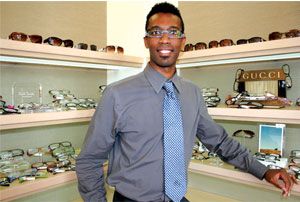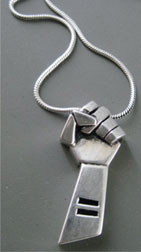Forget your game face; when choosing eyewear, give your face game
ARNOLD WAYNE JONES | Life+Style Editor jones@dallasvoice.com

SEE AND BE SEEN | Kinte Walkera with Insight Eye Care specializes in helping eyeglass wearers develop their personal style. (Arnold Wayne Jones/Dallas Voice)
Kinte Walkera has a simple motto: “If you don’t get 10 compliments in 10 days, I need to change my profession.”
That’s a pretty bold claim that few people other than personal stylists and professional sycophants could sustain. And in a way, Walkera is a stylist. His specialty is your eyes.
Walkera has decorated countless faces in his years as an eyewear specialist; he currently plies his skills at Insight Complete Eye Care on Hillcrest. It’s a more nuanced job than you might expect.
People are attached to their glasses, Walkera says, and — like a haircut, hair color or wardrobe — they resist when someone tells them they haven’t maximized their look.
“Change is very complicated,” he says. “It’s common that a person comes in and says, ‘I want something different,’ and then 99 percent of the time, they pull out exactly the same thing they came in with. People see themselves in one or two dimensions all day long. I am a stranger and I see you in all four dimensions so I can see change that works better for you.”
To work effectively, an eyewear specialist “has to garner your trust within the first 60 seconds,” he says. And the personable, exotically accented Walkera usually has no problem doing that.
It helps that he has a system. As part of a program developed by Insight called Optricks, Walkera had honed his ability to analyze how to pair a face with a frame. It’s more art than science, although it seems to work. Here’s what you can consider:
Shape. There are about four face shapes, Walkera says: Box or square, oval, elongated and round. Like matching a wine with food, choosing eyeglasses should compliment and complement your body.
“Go with the opposite of what your face is,” Walkera counsels. “For a round face, you want a square frame. Those who are elongated can wear anything they want. If your face is round, you don’t want round glasses — all you’re doing is accentuating how round you are.”
All frame purchases should take the prescription into account as well.
“The prescription will change based on the shape of the frame,” he says. “I am blind as a bat, so I could always have a small frame to offset the thickness of the lenses.”
Wider frames create a more masculine feel, and offer an architectural quality that can give the face dimension.
Color. Color can change a person’s look as well. (This is something I know from experience dealing with Walkera: He sold me a pair of black-and-red Alain Mikli frames three years ago which quickly became a signature look for me.) Walkera often quizzes customers about their profession and lifestyle before settling on a frame.
As a rule, “a harsh color establishes authority, while softer colors can be more reassuring,” he says. Someone working in the arts might go for a fun color combination.
A similar color analysis goes into matching a client’s skin tone with his frames.
“For people with dark complexions, I try to get the light colors: Indigo, purple. For those with salt-and-pepper, go with a shape of color that’s more youthful,” he says. Those wanting to shave some years off might also want to avoid cats-eye.
Don’t limit yourself. Eyeglasses don’t have to be an either/or proposition — you can have a collection. (Walkera has 62 pair at home that even his boyfriend considers a bit excessive.) Especially for guys, a variety of eyewear acts like jewelry.
“We only get to express ourselves with a few accessories: Watches, ties and glasses. Why don’t we?” Walkera asks.
He will take into account size, materials (silicon, wire, plastic) and the wearer’s own preferences. But there is one hard-and-fast rule.
“Some people want something that disappears, some bold people like to contrast,” Walkera says. Whatever you choose, own it. “If you’re gonna wear them, wear them; don’t let them wear you.”
8611 Hillcrest Road. Monday–Friday 9:30 a.m.–6 p.m., Saturday, 9:30 a.m.–4 p.m. 214-739-8611. InsightDallas.com
………………………………………….
Pride pendant recalls past movements
 When musician Jason Mraz takes an interest in something so small, it might be safe to think it’s meaning is a whole lot more. That happened to designer Carlos Antonio and his Fight For Equality necklace. Mraz saw it, liked it and now has given his name to the cause of what the pendant stands for.
When musician Jason Mraz takes an interest in something so small, it might be safe to think it’s meaning is a whole lot more. That happened to designer Carlos Antonio and his Fight For Equality necklace. Mraz saw it, liked it and now has given his name to the cause of what the pendant stands for.
“I wanted to show solidarity and an empowered fight, but a fight with knowledge,” Antonio says.
The sterling-silver necklace and pendant have rung loudly for straight allies and the community. He feels the clenched fist is a symbol people can get behind and relate to.
“I got the idea from previous movements,” Antonio says. “The rainbow or the pink triangle don’t reflect the feeling of what’s going on. But this is a symbol to feel empowered by.”
Proceeds from jewelry sales go to both Cyndi Lauper’s True Colors Fund and the American Foundation for Equal Rights.
— Rich Lopez
Available online at FightForEquality.net. $80.
This article appeared in the Dallas Voice print edition June 18, 2010.










